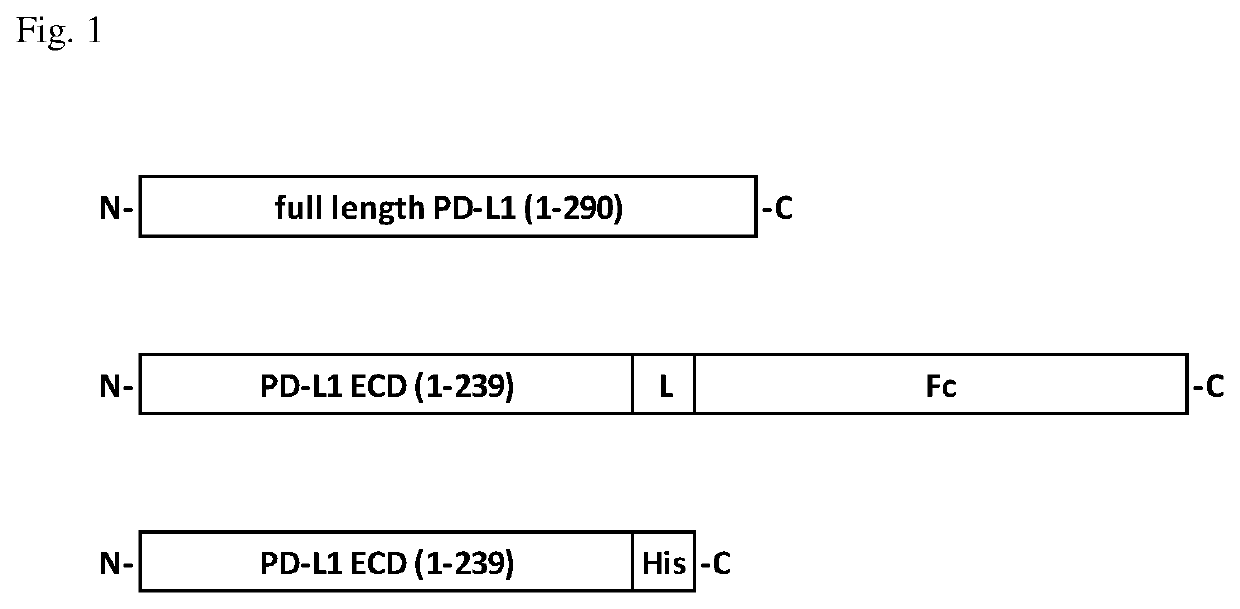Anti-PD-L1 antibodies and their use as therapeutics and diagnostics
a technology of anti-pdl1 antibodies and therapeutics, applied in the direction of antibody medical ingredients, drug compositions, peptides, etc., can solve the problems of poor prognosis of patient survival outcom
- Summary
- Abstract
- Description
- Claims
- Application Information
AI Technical Summary
Benefits of technology
Problems solved by technology
Method used
Image
Examples
example 1
n of Anti-PD-L1 Monoclonal Antibody
[0056]Murine anti-human PD-L1 monoclonal antibodies (mAbs) were generated using hybridoma fusion technology (Kohler and Milstein 1975 Nature 256:495-497; Mechetner 2007 Methods Mol Biol 378:1-13) with modifications. MAbs with high binding activities in enzyme-linked immunosorbent assay (ELISA) and fluorescence-activated cell sorting (FACS) assay were selected for further characterization in cell-based functional assays.
[0057]PD-L and CD80 Recombinant Proteins
[0058]The full length human PD-L1 cDNA was synthesized by GeneScript (Nanjing, China) based on published sequence (NCBI reference sequence NM_014143.3) (SEQ. NO. 1 and 2). The extracellular domain consisting of amino acids (AA) 1-239 of human PD-L1 (SEQ. NO. 3 and 4) was PCR-amplified and subcloned into pcDNA3.1-based expression vector (Invitrogen, Carlsbad, Calif., USA) with C-terminus fused with either a Fc region of human IgG4 or a His tag, which resulted in two recombinant PD-L1 fusion cons...
example 2
l Activities of Anti-PD-L1 Antibodies
[0076]Generation of Stable Cell Lines
[0077]The stable cell lines for human T cell-based functional assays were essentially the same as described in U.S. Pat. No. 8,735,553. Briefly, a fusion protein expression plasmid, OS8, was generated containing a scFv of anti-human CD3 mAb OKT3 and a C-terminal domain of mouse CD8a which included transmembrane and cytoplasmic domains. OS8 could function as a membrane anchored T cell engager that directly activates T-cell receptor (TCR). A stable cell line that co-expresses both OS8 and PD-L1 was generated by co-transfection of two expression constructs in HEK293 cells followed by hygromycin or G418 selection for 10-14 days. This cell line was named as HEK293 / OS8 / PD-L1. Similarly, a human T-cell line, HuT78 / PD-1, was generated that expresses human PD-1. And a reverse signaling human T-cell line, HuT78 / P3Z, was generated by stable transfection with a chimeric PD-1 expression construct (named as P3Z) made by fus...
example 3
Analysis of Murine Anti-PD-L1 Antibodies
[0094]Cloning and sequencing of variable regions from the selected murine hybridoma clones were done based on commonly used methods with some modifications (Kontermann and Dubel, 2010 Antibody Engineering, Vol 1:3-14). Briefly, bybridoma cells were harvested, washed with PBS and collected by centrifugation at 1500 rpm in a swing bucket rotor. Total cellular RNA was isolated using Ultrapure RNA kit (Cat. No. CW0581, CW Biotech, Beijing, China) following the manufacturer's protocol.
[0095]The 1st strand cDNA was synthesized using reverse transcriptase (Cat. No. AH301-02, TransGen, Beijing, China). PCR amplification of heavy chain (Vh) and light chain variable region (Vκ) of murine mAb was performed using PCR reagent kit (Cat. No. AP221-12, TransGen, Beijing, China) and a set of primers specific for cloning of murine Vh and Vκ as described (Brocks 2001 Mol Med 7:461-469). The PCR products were subcloned into the pEASY-Blunt cloning vector (Cat. No...
PUM
| Property | Measurement | Unit |
|---|---|---|
| concentration | aaaaa | aaaaa |
| concentration | aaaaa | aaaaa |
| dissociation time | aaaaa | aaaaa |
Abstract
Description
Claims
Application Information
 Login to View More
Login to View More - R&D
- Intellectual Property
- Life Sciences
- Materials
- Tech Scout
- Unparalleled Data Quality
- Higher Quality Content
- 60% Fewer Hallucinations
Browse by: Latest US Patents, China's latest patents, Technical Efficacy Thesaurus, Application Domain, Technology Topic, Popular Technical Reports.
© 2025 PatSnap. All rights reserved.Legal|Privacy policy|Modern Slavery Act Transparency Statement|Sitemap|About US| Contact US: help@patsnap.com



